-
Happy Birthday ICMag! Been 20 years since Gypsy Nirvana created the forum! We are celebrating with a 4/20 Giveaway and by launching a new Patreon tier called "420club". You can read more here.
-
Important notice: ICMag's T.O.U. has been updated. Please review it here. For your convenience, it is also available in the main forum menu, under 'Quick Links"!
You are using an out of date browser. It may not display this or other websites correctly.
You should upgrade or use an alternative browser.
You should upgrade or use an alternative browser.
Farmer's Funky Flower Trees - PPK
- Thread starter FlowerFarmer
- Start date
SRGB
Member
FlowerFarmer:
I do believe however that Mg would need added BEFORE Calnit AFTER Jacks if one was choosing to supplement Mg separately.
Hi, FlowerFarmer.
Nice garden.
The base nutrient should contain an adequate amount of Mg. Adding Mg to the base mix might not tend to cause any issues.
During experiments with SRBGB`s, we found that mixing and delivering Ca by itself resulted in providing an adequate amount of calcium, without potentially reacting with the other compunds and elements contained in the base mix.
The chemistry of calcium might tend to be more reactive than other elements of compounds contained in the base mix, which might lead to microscopic precipitate being formed; essentially converting the calcium in the solution into a solid. pH might also be a contributing factor to fluid dissolution or precipitation. We found that starting the pH at approximately 5.0 to 5.5 resulted in healthier plants or trees in SRBGB`s due to the tendency of a medium or solution to become more alkaline during cation exchange (and, correspondingly, H20 reduction within the total volume of the mix).
Perhaps your specimens are expressing a calcium deficiency. That does not necessarily mean that calcium has not been supplied to the solution; it might be that the calcium, at least in part, converted into a microscopic solid in the solution, rendering that portion unavailable to the roots.
While the base NPK-Mg-S can be mixed with CaN in the same tank, the greater the amount of calcium present, the greater the potential for the chemical reactions that might convert calcium into a microscopic solid, imperceptible to the gardener viewing the solution.
A drenching through the medium and cycling through the system with a 100% solution of CaN might deliver calcium to the root zone and the collidial surfaces of the medium. A drenching with Mg alone following that might additionally be helpful.
Another note that we found during experiments that we might have posted about previously is the potential for misdiagnosis of a calcium or magnesium deficiency or `lockout` (nutrient imbalance), when the issue might be Fe (iron) deficiency or `lockout`. However, once iron deficiency is visible to the gardener, it might have already progressed to the degree where necrosis ensues within days. Calcium and magnesium deficiencies or `lockout` might tend to be easier to manage than iron deficiencies. Reducing the pH to a more acid 5.0 to 5.5 might tend to permit iron solubility within the solution for a greater period duing cation exchange. Calcium deficiency might tend to appear first at the tops of the respective branches, as it is less able to reach those parts if is in more of solid form, traveling to those plant or tree parts with water (paleness of color). Magnesium deficiency might tend to appear first on the lower, youngest leaves (yellowing, small yellow spots). Iron deficiency could be induced by too high a pH, to wet a medium, or not enough oxygen in the medium. Leaves turn yellow to brown at the tops first, quickly proceeding to shriveling and paleness through the plant or tree; it might be difficult for the gardener to recover a specimen from severe iron deficiency or lockout, yet a drenching of a basic iron supplement might help.
Preventative steps might be a light foliar spray of one of the several supplements containing only Ca, Mg and Fe. Or, if the gardner has the individual elements, perhaps apply them individually as a light foliar spray and, or, a drenching of the media with the above elements as a standalone application once or twice during a given cycle or season. Ideally, a gardener might mix and deliver CaN entirely separately from the remainder of the base mix. Where not practical or possible due to the system, a standalone drenching, periodically (one a week, or once or twice during the cycle or season) might also be an option for the gardener to consider.
This post is only intended to share some of our observations while experimenting over an appreciable range of extremes with SRBGB`s. It is not intended to be any definitive post about any of the topics mentioned. There might be slight adjustments to the mixing of and delivery of nutrients that could potentially reduce the deficiencies or `lockouts` that you might experience during particular transitional stages during the growth, development and fruiting of the given plant or tree. We are only sharing several options that might be considered by the soilless gardener.
If you would like for us to remove this post from your thread, please PM us or post here.
Respectfully,
/SRGB/
I do believe however that Mg would need added BEFORE Calnit AFTER Jacks if one was choosing to supplement Mg separately.
Hi, FlowerFarmer.
Nice garden.
The base nutrient should contain an adequate amount of Mg. Adding Mg to the base mix might not tend to cause any issues.
During experiments with SRBGB`s, we found that mixing and delivering Ca by itself resulted in providing an adequate amount of calcium, without potentially reacting with the other compunds and elements contained in the base mix.
The chemistry of calcium might tend to be more reactive than other elements of compounds contained in the base mix, which might lead to microscopic precipitate being formed; essentially converting the calcium in the solution into a solid. pH might also be a contributing factor to fluid dissolution or precipitation. We found that starting the pH at approximately 5.0 to 5.5 resulted in healthier plants or trees in SRBGB`s due to the tendency of a medium or solution to become more alkaline during cation exchange (and, correspondingly, H20 reduction within the total volume of the mix).
Perhaps your specimens are expressing a calcium deficiency. That does not necessarily mean that calcium has not been supplied to the solution; it might be that the calcium, at least in part, converted into a microscopic solid in the solution, rendering that portion unavailable to the roots.
While the base NPK-Mg-S can be mixed with CaN in the same tank, the greater the amount of calcium present, the greater the potential for the chemical reactions that might convert calcium into a microscopic solid, imperceptible to the gardener viewing the solution.
A drenching through the medium and cycling through the system with a 100% solution of CaN might deliver calcium to the root zone and the collidial surfaces of the medium. A drenching with Mg alone following that might additionally be helpful.
Another note that we found during experiments that we might have posted about previously is the potential for misdiagnosis of a calcium or magnesium deficiency or `lockout` (nutrient imbalance), when the issue might be Fe (iron) deficiency or `lockout`. However, once iron deficiency is visible to the gardener, it might have already progressed to the degree where necrosis ensues within days. Calcium and magnesium deficiencies or `lockout` might tend to be easier to manage than iron deficiencies. Reducing the pH to a more acid 5.0 to 5.5 might tend to permit iron solubility within the solution for a greater period duing cation exchange. Calcium deficiency might tend to appear first at the tops of the respective branches, as it is less able to reach those parts if is in more of solid form, traveling to those plant or tree parts with water (paleness of color). Magnesium deficiency might tend to appear first on the lower, youngest leaves (yellowing, small yellow spots). Iron deficiency could be induced by too high a pH, to wet a medium, or not enough oxygen in the medium. Leaves turn yellow to brown at the tops first, quickly proceeding to shriveling and paleness through the plant or tree; it might be difficult for the gardener to recover a specimen from severe iron deficiency or lockout, yet a drenching of a basic iron supplement might help.
Preventative steps might be a light foliar spray of one of the several supplements containing only Ca, Mg and Fe. Or, if the gardner has the individual elements, perhaps apply them individually as a light foliar spray and, or, a drenching of the media with the above elements as a standalone application once or twice during a given cycle or season. Ideally, a gardener might mix and deliver CaN entirely separately from the remainder of the base mix. Where not practical or possible due to the system, a standalone drenching, periodically (one a week, or once or twice during the cycle or season) might also be an option for the gardener to consider.
This post is only intended to share some of our observations while experimenting over an appreciable range of extremes with SRBGB`s. It is not intended to be any definitive post about any of the topics mentioned. There might be slight adjustments to the mixing of and delivery of nutrients that could potentially reduce the deficiencies or `lockouts` that you might experience during particular transitional stages during the growth, development and fruiting of the given plant or tree. We are only sharing several options that might be considered by the soilless gardener.
If you would like for us to remove this post from your thread, please PM us or post here.
Respectfully,
/SRGB/
Pretty sure.
I'm doing 130g of Jacks + 86g of CalNit. I do this in a 50Gal barrel for around 1.2EC. I do this in slightly less water to give me a stronger mix of around 1.5EC
I'll first dissolve each in a 3.5 Gal bucket until fully dissolved. I'll then add the jacks bucket to my barrel and let it mix for a while.. then add the CalNit bucket.
___________
I was mixing via EC on my truncheon (in my previous coco circles room), but you recommended the above in a prior PM as we were finding it odd that amounts that I was adding in to achieve 1.2EC. I was previously mixing Jacks to about .7EC and then adding calnit to a 1.2EC
Below is my quoted PM to you back around March/2013. The grams I was using must not have made much sense so you advised me to revert to weighing to ensure I was hitting a .66 ratio.
I have however cleaned and confirmed my truncheon is accurate. It now is in fact reading 2.77EC in bluelabs conductivity standard solution.
This was what you suggested prior. Should I go back to measuring by EC? My truncheon is definitely ON according to the bluelab solution.
____
HL has directed me to some photos of a potassium lockout/issue and they look identical to what I've been experiencing.
My question.. is my mix boogered up, or is it merely uptake issues (due to the over-watering)(lack of proper charge)(or pH?) resulting in potassium lockout.
Joe Fresh sick plant guide picture.
View Image
My latest photo. I think the majority are growing out of it. Been slowly pulling fans to see if I can identify if the issues remains. Hard for me to tell though.
View Image
I have been finding it difficult to keep my pH down even though my bulk res is currently sitting at 1.5EC and around 5.4pH. My pulse res however climbs up and is sitting at 6.5 now. I've found it at 6.8 before. I've sometimes been doing just a splash of down into my pulse res to correct to 6.0, but it quickly goes back up after a few cycles which is what I expected as I can't alter my pulse res pH itself much, and my lower bulk res pH doesnt seem to be pulling it down over time.
I think things are improving, but I'm all ears guys if you've got any suggestions.
well, your weight method is correct but if your meter is valid you might try it that way too. .9 and .6 for 1.5. but you are in ro water, right?
i've never seen ph 6.8 with jacks. with my old ro water or my new 110 ppm tap water.
no ph adjusters in either case. in the past if the ph ever got over 6.4 i would change the solution because 6.5 is about the starting point for precipitation to begin. but it rarely does. i'm still running the original filling with only input and and it is 5.9 right now at 870 ppm. i won't change it at 6.4 but watch it closely. it usually floats back down.
you are correct about adding the jacks first. then any magnesium sulfate, if necessary. then the calcium nitrate in that order to avoid precip events.
if you are still in the vegetative stage the ec should be pulled downward sharply and the ph will rise. conversely in flower the ec will rise from your starting point but will plateau off somewhere around 1100-1200 ppm if your input is balanced. ph is pulled downward, sometimes to as low as 5.0-5.2. i don't worry about low ph very much as it is nowhere near as dangerous as high ph.
most of the folks attracted to the ppk so far have come from some sort of conventional hydro background and i see a lot of them approaching this device with a traditional hydro management strategy.
really, this device is so stable that you should not chase ph or a certain ec. let the system and the plants tell you when it's time to change the solution.
your ec can fluctuate tremendously and it won't hurt you at all. so i watch for ph changes more than anything but only check it maybe weekly unless it's close to some point then it is checked daily.
my goal in the perpetual set up is to find the input ec point that allows the solution to just sort of float along within a relatively narrow ec range that is stable. and not over about 1250 ppm. i like it around 1000-1100 and have run this type of set up for up to 8 months without dumping the solution. typically an input of around 600 ppm or ec 1.2 does this but i'll have to find it again here in the new room.
ec stays stable and ph stays stable.
in your situation where you are running the plants together as a unit you will see definite trends at different points in the plants' lives.
i confess to being a little baffled by your displays. even if you stripped all of the atami's nutrient charge out of it you should have totally straightened out by now.
i don't know but maybe it has to do with mixing and then adding concentrated solution.
i know folks do it all the time but any time you dump one strength of solution into a weaker or stronger one you can have problems.
there has to be, at least briefly, at period of time where the solution is diffusing. with all the compounds involved, the reaction speeds are different slightly.
i take one body of water, approx 42 gals in a brute 44 and add the jacks dry by the spoon directly into it. stir in, wait a few, stir again and add the calcinit. stir it all together and forget about it.
the drums are empty every time before i will mix in them so i don't have to mix into an existing body of solution.
so then we have a pre-mixed, very stable solution, feeding a very stable solution through a three step blending process. the main body of solution is changed very slowly.
i don't know if this has anything to do with what happened here but it's worth a thought. i have never seen a display like that using ro and jacks with nothing else in the water.
my first few coco plants i did not rinse and pre-charge and they displayed significantly but straightened out after a week or two. something else happened to your plants. maybe a combination of things but is it very hard to pin down.
i never saw any display after the high ec pour through and i ran coco for most of a year in the original thread.
now i want to get a bag of coco.
at 6.5 ph i would change the solution just to be safe. maybe you are slowly correcting a stimulation or an antagonism.
this could cause a release of stored cations or an ongoing binding of them.
oh yeah, i got a pm from the grower of the 1007 gr plant. it was grown in 2.5 gals of coco in a 3.5 gal bucket with a full saturation pulse using cheap coco.
this bothers me!
Thanks for the replies.
To be clear my pH of 6.5 or so in the pulse res isnt what I am getting after mixing up my Jacks+CalNit in RO. It actually nets me a pH of around 5.2-5.4. This might climb on its own a bit, but my bulk res has been consistently testing in the low to mid 5's while my pulse res is always 6.4ish.
It must be only after the pulse/feed cycles that I'm seeing the rise in pH. I initially thought this was due to too low EC so I started pumping into my bulk res at 1.5 as opposed to the 1.2. I am running sealed/co2.
I will add that I'm mixing in my RO barrel. I mix as I described in my previous post and pump it all to my bulk res with a large pump.. now, this does leave me with a few (1-2 gallons maybe?) in the bottom of my 55gal drum that the pump can't pick up off of the bottom. I ignore this amount and flip a switch to refill back with RO. You don't think this could be giving me problems do you? My RO refills never register on my truncheon so it's got to be pretty low ppm.
Tomorrow I think I'm going to try to drain the system completely and re-dose with a fresh batch made in a clean/empty container measured by EC as opposed to weight without doing the bucket concentrates.
I'll keep up with the weekly updates sink or swim. Hoping that while despite the issues I'll still bring this to a successful harvest as opposed to Dave's unfortunate death mid-bloom.
Only time will tell...
PS - despite my less then flawless plants I really am loving how boring this shit is. Cant wait to go turface. I've got a bit of outdoor space so I better get building my slide.

To be clear my pH of 6.5 or so in the pulse res isnt what I am getting after mixing up my Jacks+CalNit in RO. It actually nets me a pH of around 5.2-5.4. This might climb on its own a bit, but my bulk res has been consistently testing in the low to mid 5's while my pulse res is always 6.4ish.
It must be only after the pulse/feed cycles that I'm seeing the rise in pH. I initially thought this was due to too low EC so I started pumping into my bulk res at 1.5 as opposed to the 1.2. I am running sealed/co2.
I will add that I'm mixing in my RO barrel. I mix as I described in my previous post and pump it all to my bulk res with a large pump.. now, this does leave me with a few (1-2 gallons maybe?) in the bottom of my 55gal drum that the pump can't pick up off of the bottom. I ignore this amount and flip a switch to refill back with RO. You don't think this could be giving me problems do you? My RO refills never register on my truncheon so it's got to be pretty low ppm.
Tomorrow I think I'm going to try to drain the system completely and re-dose with a fresh batch made in a clean/empty container measured by EC as opposed to weight without doing the bucket concentrates.
I'll keep up with the weekly updates sink or swim. Hoping that while despite the issues I'll still bring this to a successful harvest as opposed to Dave's unfortunate death mid-bloom.
Only time will tell...
PS - despite my less then flawless plants I really am loving how boring this shit is. Cant wait to go turface. I've got a bit of outdoor space so I better get building my slide.

oh yea,
I've been giving other plants (not-ppk) the same juice and they exhibit none of these symptoms - they look rather flawless. Everything gets the same thing from clones in solo cups to larger coco plants in 2 gal pots. These all get watered with a wand out of my bulk tank (or the solution in my barrel before sending to my bulk tank). They are all however under T5.
This baffles me honestly..
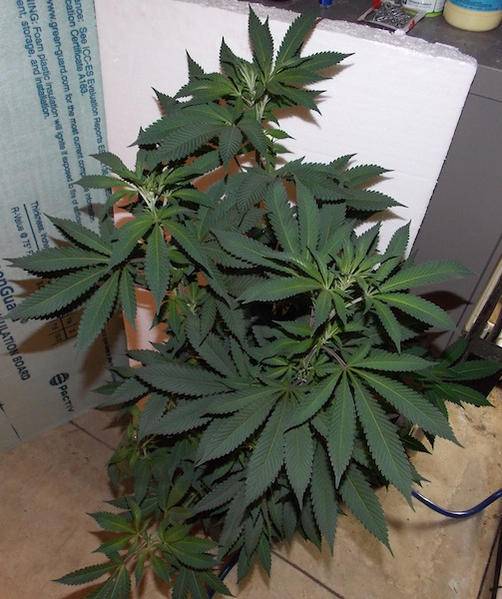
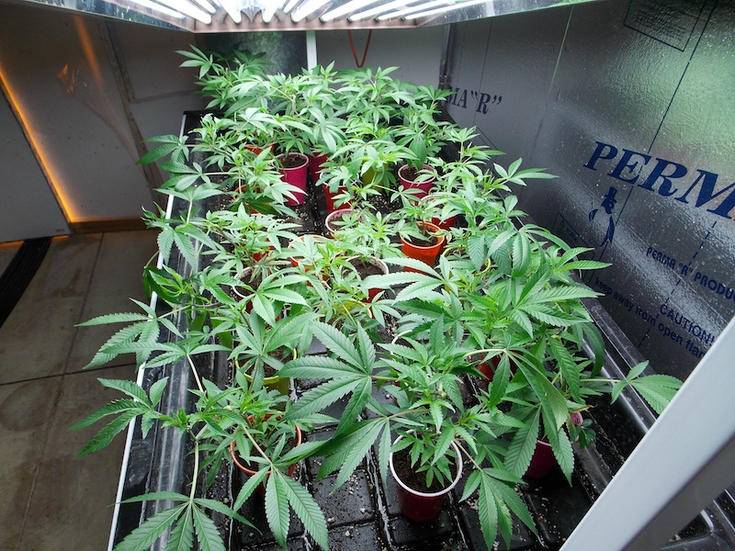
I've been giving other plants (not-ppk) the same juice and they exhibit none of these symptoms - they look rather flawless. Everything gets the same thing from clones in solo cups to larger coco plants in 2 gal pots. These all get watered with a wand out of my bulk tank (or the solution in my barrel before sending to my bulk tank). They are all however under T5.
This baffles me honestly..
Last edited:
Just took some readings..
Bulk Res - pH 5.5, EC is 1.5
Pulse Res - pH 6.5, EC is 1.2
Do you think that I need to make my bulk res stronger yet... maybe somewhere near 1.8 to 2.0 EC. This is what I previously used when running recirculating water culture (although not in coco).
Bulk Res - pH 5.5, EC is 1.5
Pulse Res - pH 6.5, EC is 1.2
Do you think that I need to make my bulk res stronger yet... maybe somewhere near 1.8 to 2.0 EC. This is what I previously used when running recirculating water culture (although not in coco).
SRGB
Member
FlowerFarmer:
HL has directed me to some photos of a potassium lockout/issue and they look identical to what I've been experiencing.
My question.. is my mix boogered up, or is it merely uptake issues (due to the over-watering)(lack of proper charge)(or pH?) resulting in potassium lockout.
--
oh yea,
I've been giving other plants (not-ppk) the same juice and they exhibit none of these symptoms - they look rather flawless. Everything gets the same thing from clones in solo cups to larger coco plants in 2 gal pots. These all get watered with a wand out of my bulk tank (or the solution in my barrel before sending to my bulk tank). They are all however under T5.
This baffles me honestly..
Hi, FlowerFarmer.
Many plants and trees can absorb a fairly large amount of potassium compared to other elements or compounds, without expressing any significant symptoms of `burn`. Most plant nutrients include potassium in their dry or liquid mixes at roughly 30% of the mix, or more. There might be enough K in an average nutrient base mix to adequately provide that element to plant or tree roots.
Overwatering might be an area to examine, particularly where coco coir is the sole medium, especially if a nutrient solution is actively recirculated.
Do the wand watered plants drain to waste, without recirculation? Does your system recirculate the same nutrients after a pulse feed and drain through the system?
The nutrient solution might tend to alter its composition at every stage of its circuit through the system. From mixing in the tank (if mixed with too much calcium, potentially reacting to form precipitates), to movement through feed lines (friction, potential for reaction in feed line), to substrate (potential for reaction with media, especially coco coir`s affinity for influencing available nutrients during cation exchange), to root zone (roots exchanging electrical charges with surfaces of the media and solution), to drainage out of the root zone and back through the feed loop to a centralized tank (changes in the chemical composition and pH of the solution).
Wand watered plants might tend to subtract several of the above variables from an equation involving potential factors influencing the nutrient solution`s composition.
If a given solution is recirculated, it might generally tend to change its chemical properties in response to the surfaces and organic matter (roots, coco coir, et al.) it might come into contact with. Manageable, yet each variables` weighted value in influencing the available nutrient profile might be examined at each point of contact.
That is, for example, not only measuring the input pH, EC, mmho, etc., but also digging into the media to extract and examine the properties of that media, preferably from the center of the container. Additionally measuring the properties of the run off that drains into the catch, or pre-recirculation vessel. Then calculating - and measuring - its influence on the bulk tank holding the amassed volume of the nutrient solution - if that run off returns to the centralized tank. We found during experiments with SRBGB`s that to accurately review the efficacy of a given nutrient solution, and, or, a nutrient solutions` efficacy with a given medium, we retrieved the most accurate data sets by examining each variable that held the potential to contact or alter the nutrient solution.
Of course, the examination does not have to be that involved; but to accurately determine the cause of the transition symptoms that you have described, further consideration of variables beyond those of input nutrient solution might be helpful.
In any event, your system and plants, from your posts, seem to have recovered from the brief period of visual adverse symptoms. As we alluded to in our previous post, all that might be required for healthy growth throughout each stage or transition period in your system, are perhaps slight adjustments to the general variables metnioned above.
Hope this helps. Nice gardening.
Best,
/SRGB/
HL has directed me to some photos of a potassium lockout/issue and they look identical to what I've been experiencing.
My question.. is my mix boogered up, or is it merely uptake issues (due to the over-watering)(lack of proper charge)(or pH?) resulting in potassium lockout.
--
oh yea,
I've been giving other plants (not-ppk) the same juice and they exhibit none of these symptoms - they look rather flawless. Everything gets the same thing from clones in solo cups to larger coco plants in 2 gal pots. These all get watered with a wand out of my bulk tank (or the solution in my barrel before sending to my bulk tank). They are all however under T5.
This baffles me honestly..
Hi, FlowerFarmer.
Many plants and trees can absorb a fairly large amount of potassium compared to other elements or compounds, without expressing any significant symptoms of `burn`. Most plant nutrients include potassium in their dry or liquid mixes at roughly 30% of the mix, or more. There might be enough K in an average nutrient base mix to adequately provide that element to plant or tree roots.
Overwatering might be an area to examine, particularly where coco coir is the sole medium, especially if a nutrient solution is actively recirculated.
Do the wand watered plants drain to waste, without recirculation? Does your system recirculate the same nutrients after a pulse feed and drain through the system?
The nutrient solution might tend to alter its composition at every stage of its circuit through the system. From mixing in the tank (if mixed with too much calcium, potentially reacting to form precipitates), to movement through feed lines (friction, potential for reaction in feed line), to substrate (potential for reaction with media, especially coco coir`s affinity for influencing available nutrients during cation exchange), to root zone (roots exchanging electrical charges with surfaces of the media and solution), to drainage out of the root zone and back through the feed loop to a centralized tank (changes in the chemical composition and pH of the solution).
Wand watered plants might tend to subtract several of the above variables from an equation involving potential factors influencing the nutrient solution`s composition.
If a given solution is recirculated, it might generally tend to change its chemical properties in response to the surfaces and organic matter (roots, coco coir, et al.) it might come into contact with. Manageable, yet each variables` weighted value in influencing the available nutrient profile might be examined at each point of contact.
That is, for example, not only measuring the input pH, EC, mmho, etc., but also digging into the media to extract and examine the properties of that media, preferably from the center of the container. Additionally measuring the properties of the run off that drains into the catch, or pre-recirculation vessel. Then calculating - and measuring - its influence on the bulk tank holding the amassed volume of the nutrient solution - if that run off returns to the centralized tank. We found during experiments with SRBGB`s that to accurately review the efficacy of a given nutrient solution, and, or, a nutrient solutions` efficacy with a given medium, we retrieved the most accurate data sets by examining each variable that held the potential to contact or alter the nutrient solution.
Of course, the examination does not have to be that involved; but to accurately determine the cause of the transition symptoms that you have described, further consideration of variables beyond those of input nutrient solution might be helpful.
In any event, your system and plants, from your posts, seem to have recovered from the brief period of visual adverse symptoms. As we alluded to in our previous post, all that might be required for healthy growth throughout each stage or transition period in your system, are perhaps slight adjustments to the general variables metnioned above.
Hope this helps. Nice gardening.
Best,
/SRGB/
I think that the small amount left in the bottom does eventually cause problems over time. I was doing the same thing as you, just leaving the small amount of solution in the bottom and refilling the res. This bugged me, so I got a pump that pumps down to a half inch then automatically turns off. Then I fill the res back up 1/4-1/2 way with tap water and drain it out, then I fill with RO or filtered water.Thanks for the replies.
To be clear my pH of 6.5 or so in the pulse res isnt what I am getting after mixing up my Jacks+CalNit in RO. It actually nets me a pH of around 5.2-5.4. This might climb on its own a bit, but my bulk res has been consistently testing in the low to mid 5's while my pulse res is always 6.4ish.
It must be only after the pulse/feed cycles that I'm seeing the rise in pH. I initially thought this was due to too low EC so I started pumping into my bulk res at 1.5 as opposed to the 1.2. I am running sealed/co2.
I will add that I'm mixing in my RO barrel. I mix as I described in my previous post and pump it all to my bulk res with a large pump.. now, this does leave me with a few (1-2 gallons maybe?) in the bottom of my 55gal drum that the pump can't pick up off of the bottom. I ignore this amount and flip a switch to refill back with RO. You don't think this could be giving me problems do you? My RO refills never register on my truncheon so it's got to be pretty low ppm.
Tomorrow I think I'm going to try to drain the system completely and re-dose with a fresh batch made in a clean/empty container measured by EC as opposed to weight without doing the bucket concentrates.
I'll keep up with the weekly updates sink or swim. Hoping that while despite the issues I'll still bring this to a successful harvest as opposed to Dave's unfortunate death mid-bloom.
Only time will tell...
PS - despite my less then flawless plants I really am loving how boring this shit is. Cant wait to go turface. I've got a bit of outdoor space so I better get building my slide.

Well,
near my wits end with coco right now. I'm thinking about just throwing to 12/12 so I can get on with this grow and run turface next round.
I thought things were growing out of their issues... the plants are bigger, but seem to have lost their vigor. I'm seeing twisty leaves and otherwise lack luster growth.
I cant tell what the yellowing is doing, but its definitely back with a vengeance on one plant. My T5 solo cup clones are now also exhibiting similar issues.
Cant get my pulse res pH down. It always want to climb back to 6.5 despite my bulk res being set at 5.5. I have noticed that my pulse res dropped down to 1.1EC so I've just started loading my bulk res to 1.6EC.. thinking I may be too weak and underfeeding them. I might go all the way to 2.0EC if I can't sort this out and see what happens at a stronger strength. After my last post I did pump out pulse res and refill with new juice. pH climbs back to 6.5 after a couple of pulse cycles.
Roots seems to have filled the upper container entirely. I can no longer dig out a big of coco. Curious if I should adjust my interval. I'm doing 1min every 1hr 45min. 1 minute pulse the last time I checked gives me a 64oz feed.
Here is what we are looking like. Sorry for the crappy shots...cam batts were dying after ever picture. I had to work fast.
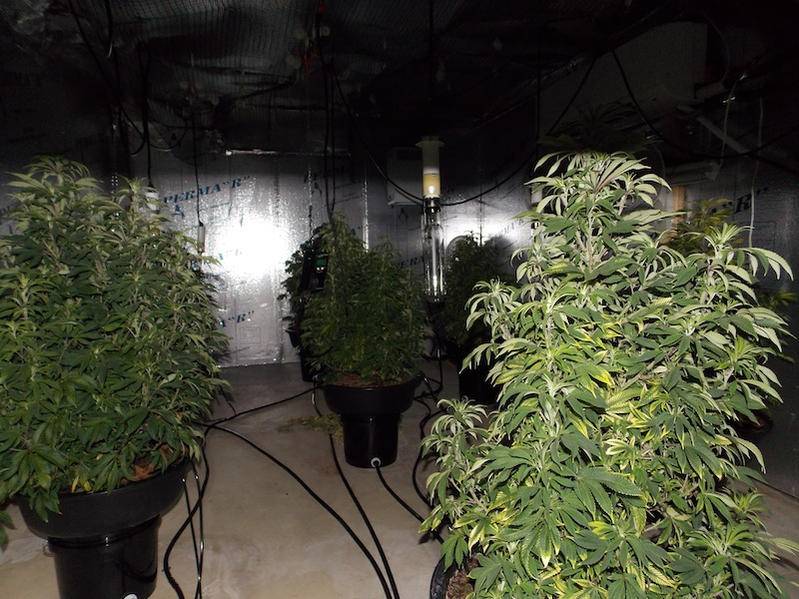
hog in the room
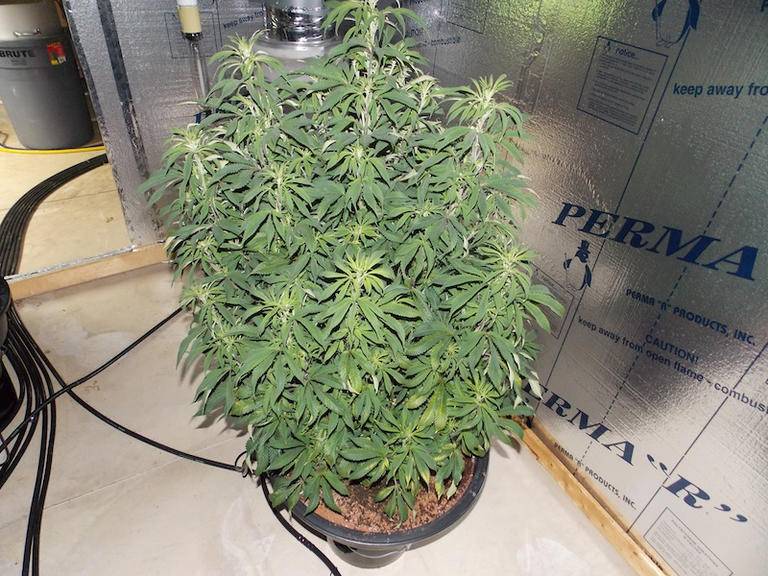
I absolutely hate seeing poor twisty growth as pictured below. pH issues/lockout? Would I benefit from disconnecting from the pulse res and running these ladies DTW to give me a good flush... then resume the PPK method.
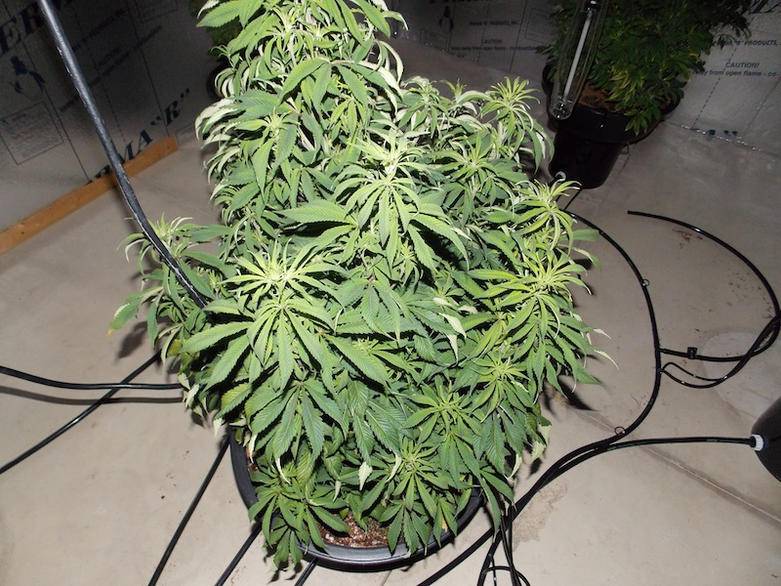
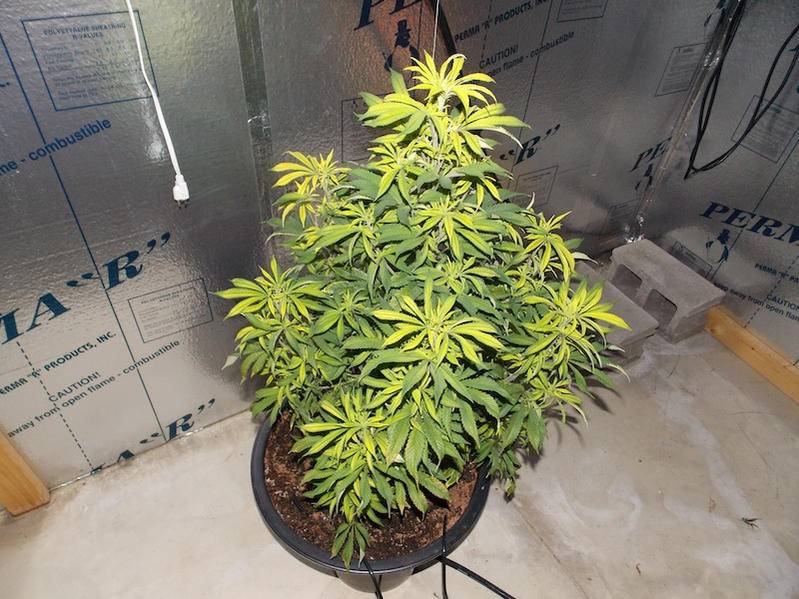
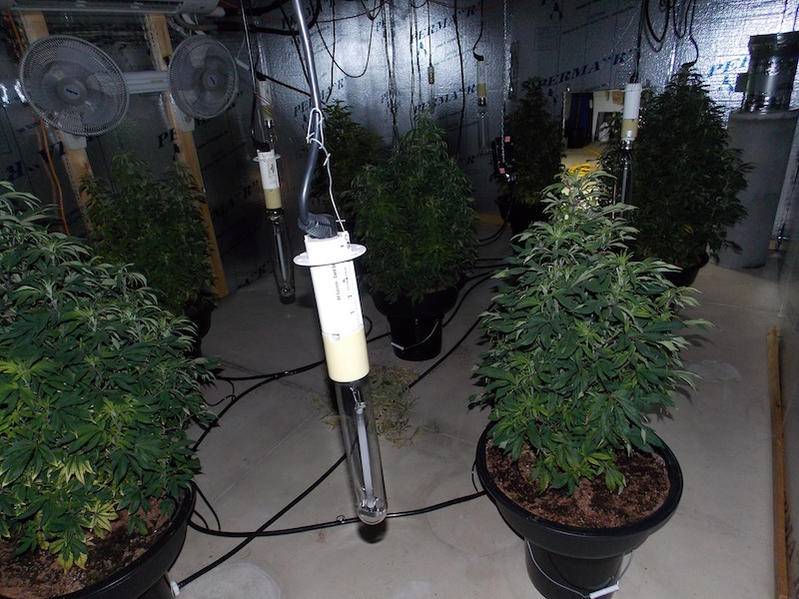
More to follow
near my wits end with coco right now. I'm thinking about just throwing to 12/12 so I can get on with this grow and run turface next round.
I thought things were growing out of their issues... the plants are bigger, but seem to have lost their vigor. I'm seeing twisty leaves and otherwise lack luster growth.
I cant tell what the yellowing is doing, but its definitely back with a vengeance on one plant. My T5 solo cup clones are now also exhibiting similar issues.
Cant get my pulse res pH down. It always want to climb back to 6.5 despite my bulk res being set at 5.5. I have noticed that my pulse res dropped down to 1.1EC so I've just started loading my bulk res to 1.6EC.. thinking I may be too weak and underfeeding them. I might go all the way to 2.0EC if I can't sort this out and see what happens at a stronger strength. After my last post I did pump out pulse res and refill with new juice. pH climbs back to 6.5 after a couple of pulse cycles.
Roots seems to have filled the upper container entirely. I can no longer dig out a big of coco. Curious if I should adjust my interval. I'm doing 1min every 1hr 45min. 1 minute pulse the last time I checked gives me a 64oz feed.
Here is what we are looking like. Sorry for the crappy shots...cam batts were dying after ever picture. I had to work fast.
hog in the room
I absolutely hate seeing poor twisty growth as pictured below. pH issues/lockout? Would I benefit from disconnecting from the pulse res and running these ladies DTW to give me a good flush... then resume the PPK method.
More to follow
Last edited:
Now exhibiting issues in my coco solo cups now under T5 veg. This has been getting feed out of the bulk res. I jinxed myself by stating previously that it was flawless and unaffected.
Not really sweating it though as these will be transferred to Pure Knowledge soil mix in another location/ horizontal adjust a wings. Just flipped it's twin tent and they have been doing great so far.. water only.
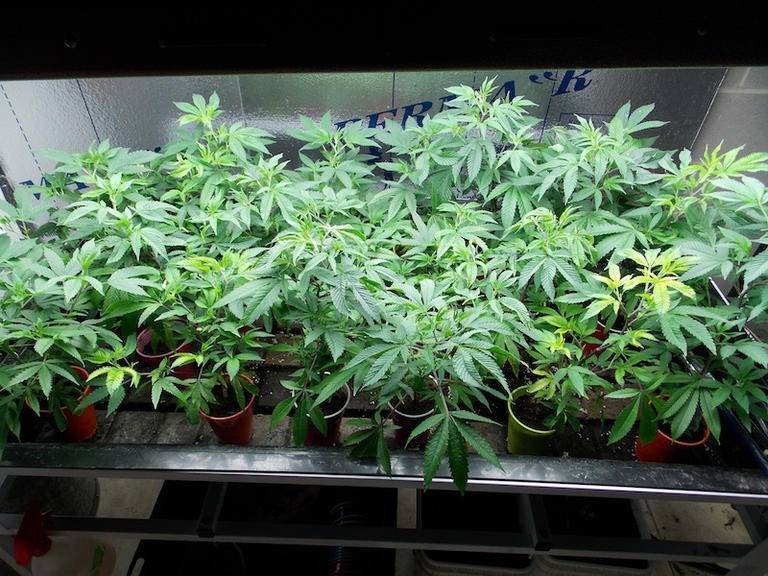
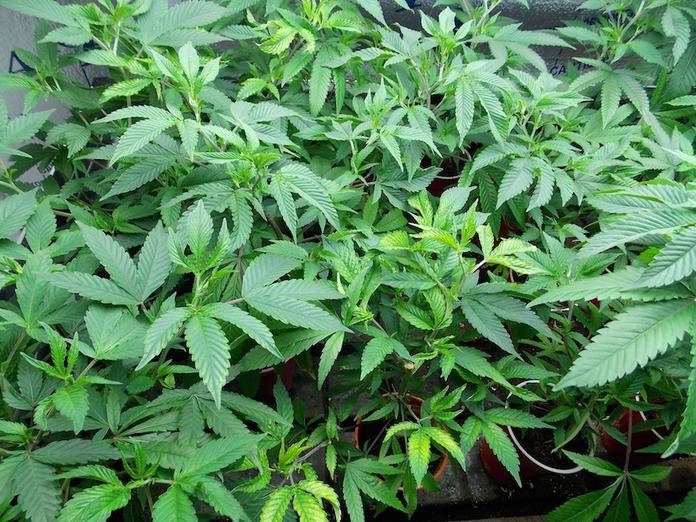
Not really sweating it though as these will be transferred to Pure Knowledge soil mix in another location/ horizontal adjust a wings. Just flipped it's twin tent and they have been doing great so far.. water only.
My little 1k donut also fed from the same bulk res trucking right along with no issue (knock on wood). This is just handwatered coco.
Knowing my track record this will go downhill soon and I'll just barely scrap a successful harvest out it.. lol
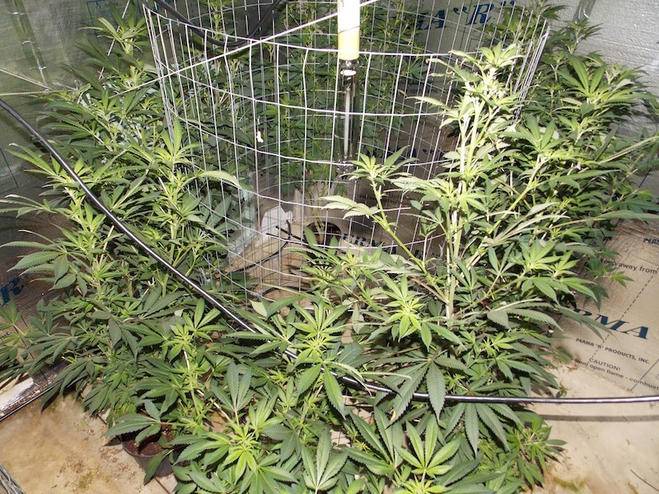
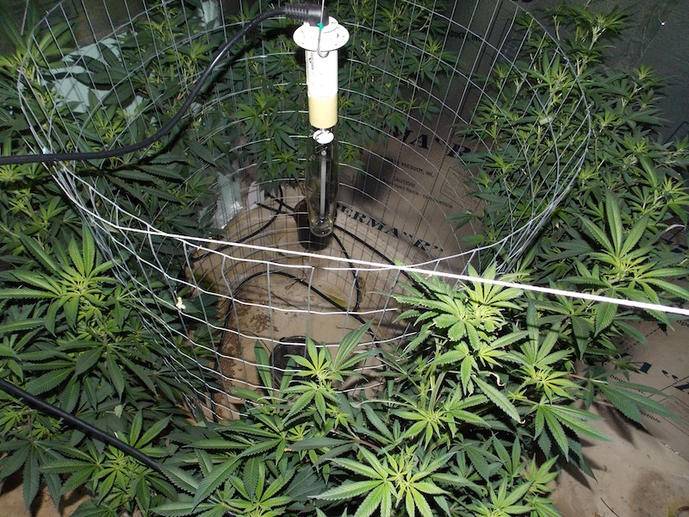
Knowing my track record this will go downhill soon and I'll just barely scrap a successful harvest out it.. lol
transitional
-1st photo set (Day 1 Veg) removed due to picture limit-
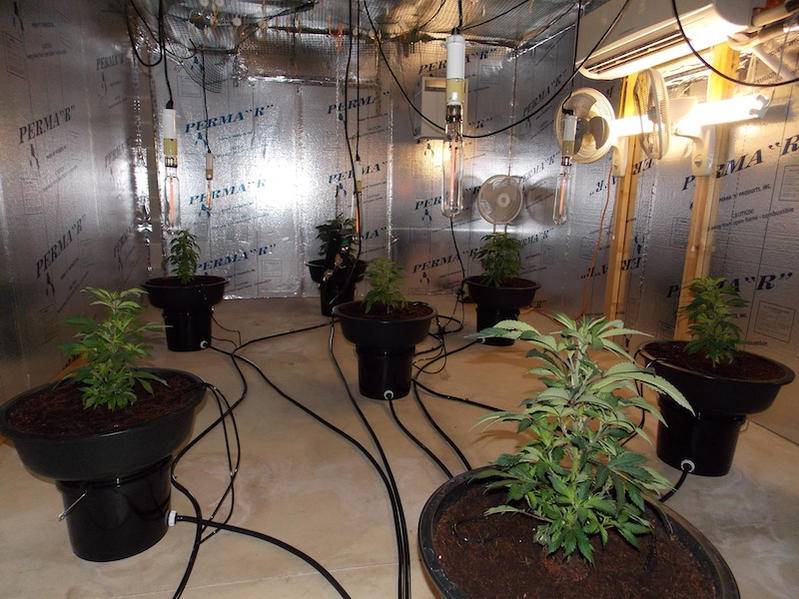
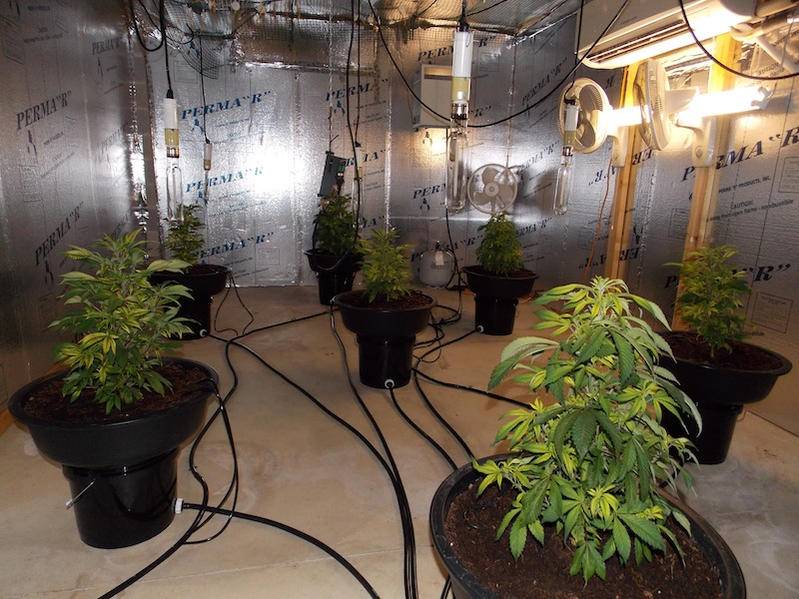
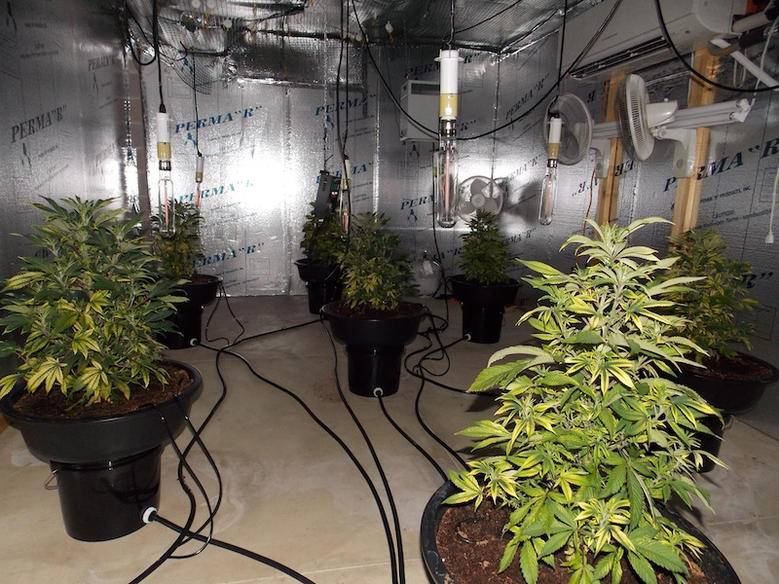
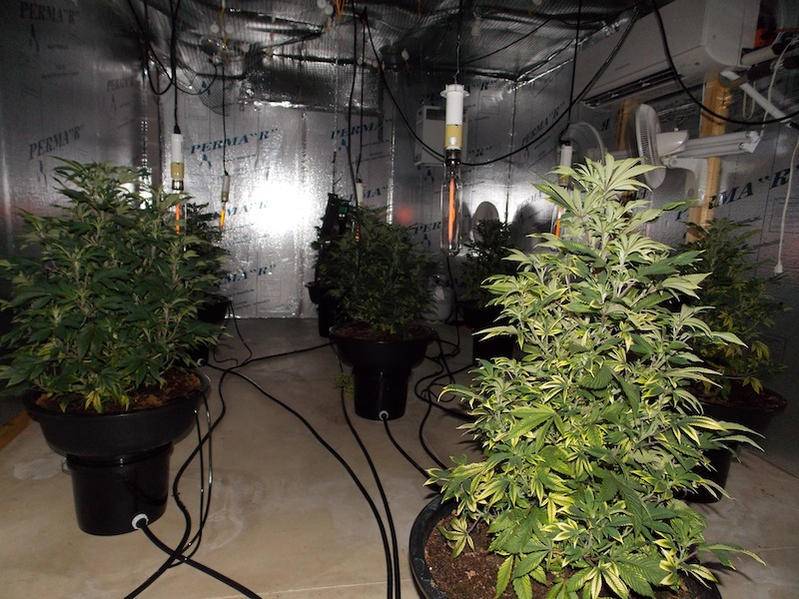

-1st photo set (Day 1 Veg) removed due to picture limit-
hey FF! i'm truly baffled by this. jack's 5-12-26 hydro special with calcinit and atami coco. this is precisely what i used to grow my personal best plant.
ro water, right?
the only thing i can think of is that the medium is staying too wet or some type of toxin is in the system.
what is your watering schedule right now?
drop the air gap down another 1/2" just for effect.
ro water, right?
the only thing i can think of is that the medium is staying too wet or some type of toxin is in the system.
what is your watering schedule right now?
drop the air gap down another 1/2" just for effect.
RO water
I'm doing 64oz every 1.5 hours. I can't dig any coco out of the pots anymore, but what little bit I can get only lets out drops when squeezed tight.
My blumat garden definitely ran dryer then this so maybe I should perhaps back off for a bit. Do you think it'd be beneficial to maybe kill the top feed entirely for a day or so and allow only wicking.
I've seen the janky leaves/poor growth before in coco methods and flipping to 12/12 normally rockets me out of it as things stretch, but I'd really prefer to be 100% healthy before the flip. Maybe I'll try dropping to 18/6 lighting schedule to see if some dark period would help.
Some kind of transpiration issues?
I'm doing 64oz every 1.5 hours. I can't dig any coco out of the pots anymore, but what little bit I can get only lets out drops when squeezed tight.
My blumat garden definitely ran dryer then this so maybe I should perhaps back off for a bit. Do you think it'd be beneficial to maybe kill the top feed entirely for a day or so and allow only wicking.
I've seen the janky leaves/poor growth before in coco methods and flipping to 12/12 normally rockets me out of it as things stretch, but I'd really prefer to be 100% healthy before the flip. Maybe I'll try dropping to 18/6 lighting schedule to see if some dark period would help.
Some kind of transpiration issues?
Last edited:
i was having a very similar issue with my trees in coco... all it took was letting em get a bit dryer and watering less. straight coco seems to hold a bit too much water.
definitely switch to 18/6, let them get a bit of rest. i was having some stress issues that disappeared after switching.
definitely switch to 18/6, let them get a bit of rest. i was having some stress issues that disappeared after switching.
SRGB
Member
FlowerFarmer:
Well,
near my wits end with coco right now. I'm thinking about just throwing to 12/12 so I can get on with this grow and run turface next round.
I thought things were growing out of their issues... the plants are bigger, but seem to have lost their vigor. I'm seeing twisty leaves and otherwise lack luster growth.
I cant tell what the yellowing is doing, but its definitely back with a vengeance on one plant. My T5 solo cup clones are now also exhibiting similar issues.
Cant get my pulse res pH down. It always want to climb back to 6.5 despite my bulk res being set at 5.5. I have noticed that my pulse res dropped down to 1.1EC so I've just started loading my bulk res to 1.6EC.. thinking I may be too weak and underfeeding them. I might go all the way to 2.0EC if I can't sort this out and see what happens at a stronger strength. After my last post I did pump out pulse res and refill with new juice. pH climbs back to 6.5 after a couple of pulse cycles.
Roots seems to have filled the upper container entirely. I can no longer dig out a big of coco. Curious if I should adjust my interval. I'm doing 1min every 1hr 45min. 1 minute pulse the last time I checked gives me a 64oz feed.
Here is what we are looking like. Sorry for the crappy shots...cam batts were dying after ever picture. I had to work fast.
--
I absolutely hate seeing poor twisty growth as pictured below. pH issues/lockout? Would I benefit from disconnecting from the pulse res and running these ladies DTW to give me a good flush...
Hi, FlowerFarmer.
From what we could view in your posts, your issues might appear to be, at a minimal, calcium deficiency within the plants, perhaps some exhibiting iron deficiency.
Calcium deficiency might be easier to treat than iron deficiency. Once iron deficiency sets in, necrotic leaves quickly ensue and recovery of those affected parts of the plant or tree can become quite difficult.
One reason that the pH continues to rise might be due to the increased growth rate of your plants - coupled with the process of cation exchange.
Briefly, nitrate-based fertilizers might tend to increase the pH of the solution as a given plants` roots exchange electrical charges. Without going into too much detail, the basic formula might look something like:
Anions:
Nitrates
Phospahates
Roots absorb these ions and release hydroxyl groups (0H-) and bicarbonates (H3O3-) into the media, and, or nutrient solution.
In general, anions are the negatively charged ions (anions) that are predominantly found in the nutrient solution, as opposed to the postitively charged ions (cations) found predominanatly on the collidial surfaces of the media.
Most `hydroponic` type fertilizers are nitrate based. See the form of nitrogen on the guaranteed analysis of your base dry nutrient package.
Unlike cations, anions (i.e.g., nitrates (N03-), phosphates (HP04--), sulphates (S04--) and chlorides (Cl-)) can be easily rinsed or leached out of the medium. Overwatering, without replentishing the nutrient solution every 24 to 48hrs with a fresh batch of solution, might tend to decrease the available anions in the solution - especially with large, rapidly growing or fruiting plants or trees.
It should be noted here that plant roots exchange electrical charges - the process is reciprocal. For every electrical charge assimilated by a plants` roots, those roots release one or more electrical charges back into the solution, or onto the media particulate.
If a solution contains XXX amount of dissolved nutrient solution, the plants` roots will exchange chemicals (in the form of electrical charges) with the given solution.
For example, for the uptake of every one (1) calcium (Ca++) or magnesium (Mg++) ion, the root releases two (2) hydrogen (H+) ions - back into the solution, or onto the particulate matter of the medium. Depending on the reactivity of the media, this exchange process could be influenced by the affinity of that media to also repel or hold on to those elements, potentially affecting the availability of the nutrients in the solution - even if the solution might be freshly mixed by the gardener.
As we have noted in previous posts, overwatering might be a contributing factor to iron being less available to a plant, along with elevated pH. Overwatering might reduce the potential for available oxygen channels in the media; iron deficiency can also be caused by lack of oxygen in the media and too high of a pH, as iron becomes less soluble in a given solution the more alkaline the solution is. In either instance, both calcium and iron could be present, yet might convert to more of a solid form where the conditions of the media or solution allow for precipitates (solids) of those elements to form.
There might be a combination of these factors occurring in your systems.
We would probably recommend
A) Permitting the media to dry out some between waterings, especially if coco coir is the sole medium used;
B) Feed for 24 hours with only a calcium, magnesium, iron type solution. This could be in stages if the gardener has access to those elements in their isolated forms. Or, a pre-mixed formula such as Mag-I-Cal from Technaflora, or generic calcium nitrate followed by a generic iron supplement such as Hi-Yield liquid, or other iron-based supplement.
C) Remove severely necrotic leaves from both the older and younger specimen, to dissuade energy being drawn into them in the plants` efforts to recover in the older plants, and to force the younger plants to grow newer shoots - after being treated with a standalone application of some form of calcium and iron.
D) Foliar spray plants with one of the calcium+iron supplements, very diluted, fine mist, every week or so.
E) Consider substituting perlite or pumice for coco coir in future projects.
Both perlite and pumice should provide greater and more thorough drainage of the solution, without influencing the pH or nutrient composition of the nutrient solution. Additionally, due to the thorough drainage of inert rock-based mediums, those elements which could become concentrated in the center of the media (coco coir) due to too wet conditions - after cation exchange - might become more fluid in their drainage out of the media than coco coir.
F) Employ smaller nutrient solutions in the centralized reservoir, so that the entire reservoir is used in 24-48hrs. This might compel the gardener to replace that solution every 24-48hrs, resulting in a perpetually `fresh` nutrient solution. This can be achieved with float valves or other means if automation of the process is desired.
G) Employ periodic water-only deliveries through the system (media); as calcium is predominantly immobile and moves up through the plant with water. If the solution is reactive with calcium, or too much calcium is included within the mix, it might be that that provided calcium could become a solid before reaching the tops of the plants (where calcium deficiency most frequently can be observed initially). This does not mean that adequate amounts of calcium are not in the solution, just that media or solution compostion might not favor full transport of the provided calcium to those parts of the plants which require it (the tops, where it is stored).
Reading only input nutrient solution parameters might not provide all of the data sets needed to make accurate adjustments. As the chemicals may convert to other forms during the route through the media, contact with roots and further recirculation back out of the containers to the centralized reservoir.
If you were able to accurately calaculate the precise amount of water or nutrient solution that your garden uses per 24hr period, you could turn your existing system into a Drain-To-Waste system by simply pumping only that amount of nutrient that your garden uses over that period, and no more. This would essentially give you the option to deliver a fresh nutrient solution every day, with minimal to no waste - due to the pre-calculation of the rate at which your plants are actually using the solution. We have outlined this type of approach in our article Drain-To-No-Waste [Methods], in our subforum. The same principles could be merged into a system which delivered the nutrient by pump.
In conclusion, without attempting to post any definitive diagnosis of your garden`s specimen, we would probably examine the issues from the perspective of
a) the media being too wet
resulting in
b) iron deficiency within the plant - not within the solution; and
c) calcium deficiency within the plant due to media reactiveness based on a).
Corrective measures, again, might be to run only a calcium and or iron based supplement through the system for a few days - after leaching the system for 24hrs with pure water to rinse out elements held in the media.
The process of physical and chemical process of cation exchange, along with the above noted points, might be areas of further examination by the soilless gardener.
We hope that this post might be helpful.
Best,
/SRGB/
Well,
near my wits end with coco right now. I'm thinking about just throwing to 12/12 so I can get on with this grow and run turface next round.
I thought things were growing out of their issues... the plants are bigger, but seem to have lost their vigor. I'm seeing twisty leaves and otherwise lack luster growth.
I cant tell what the yellowing is doing, but its definitely back with a vengeance on one plant. My T5 solo cup clones are now also exhibiting similar issues.
Cant get my pulse res pH down. It always want to climb back to 6.5 despite my bulk res being set at 5.5. I have noticed that my pulse res dropped down to 1.1EC so I've just started loading my bulk res to 1.6EC.. thinking I may be too weak and underfeeding them. I might go all the way to 2.0EC if I can't sort this out and see what happens at a stronger strength. After my last post I did pump out pulse res and refill with new juice. pH climbs back to 6.5 after a couple of pulse cycles.
Roots seems to have filled the upper container entirely. I can no longer dig out a big of coco. Curious if I should adjust my interval. I'm doing 1min every 1hr 45min. 1 minute pulse the last time I checked gives me a 64oz feed.
Here is what we are looking like. Sorry for the crappy shots...cam batts were dying after ever picture. I had to work fast.
--
I absolutely hate seeing poor twisty growth as pictured below. pH issues/lockout? Would I benefit from disconnecting from the pulse res and running these ladies DTW to give me a good flush...
Hi, FlowerFarmer.
From what we could view in your posts, your issues might appear to be, at a minimal, calcium deficiency within the plants, perhaps some exhibiting iron deficiency.
Calcium deficiency might be easier to treat than iron deficiency. Once iron deficiency sets in, necrotic leaves quickly ensue and recovery of those affected parts of the plant or tree can become quite difficult.
One reason that the pH continues to rise might be due to the increased growth rate of your plants - coupled with the process of cation exchange.
Briefly, nitrate-based fertilizers might tend to increase the pH of the solution as a given plants` roots exchange electrical charges. Without going into too much detail, the basic formula might look something like:
Anions:
Nitrates
Phospahates
Roots absorb these ions and release hydroxyl groups (0H-) and bicarbonates (H3O3-) into the media, and, or nutrient solution.
In general, anions are the negatively charged ions (anions) that are predominantly found in the nutrient solution, as opposed to the postitively charged ions (cations) found predominanatly on the collidial surfaces of the media.
Most `hydroponic` type fertilizers are nitrate based. See the form of nitrogen on the guaranteed analysis of your base dry nutrient package.
Unlike cations, anions (i.e.g., nitrates (N03-), phosphates (HP04--), sulphates (S04--) and chlorides (Cl-)) can be easily rinsed or leached out of the medium. Overwatering, without replentishing the nutrient solution every 24 to 48hrs with a fresh batch of solution, might tend to decrease the available anions in the solution - especially with large, rapidly growing or fruiting plants or trees.
It should be noted here that plant roots exchange electrical charges - the process is reciprocal. For every electrical charge assimilated by a plants` roots, those roots release one or more electrical charges back into the solution, or onto the media particulate.
If a solution contains XXX amount of dissolved nutrient solution, the plants` roots will exchange chemicals (in the form of electrical charges) with the given solution.
For example, for the uptake of every one (1) calcium (Ca++) or magnesium (Mg++) ion, the root releases two (2) hydrogen (H+) ions - back into the solution, or onto the particulate matter of the medium. Depending on the reactivity of the media, this exchange process could be influenced by the affinity of that media to also repel or hold on to those elements, potentially affecting the availability of the nutrients in the solution - even if the solution might be freshly mixed by the gardener.
As we have noted in previous posts, overwatering might be a contributing factor to iron being less available to a plant, along with elevated pH. Overwatering might reduce the potential for available oxygen channels in the media; iron deficiency can also be caused by lack of oxygen in the media and too high of a pH, as iron becomes less soluble in a given solution the more alkaline the solution is. In either instance, both calcium and iron could be present, yet might convert to more of a solid form where the conditions of the media or solution allow for precipitates (solids) of those elements to form.
There might be a combination of these factors occurring in your systems.
We would probably recommend
A) Permitting the media to dry out some between waterings, especially if coco coir is the sole medium used;
B) Feed for 24 hours with only a calcium, magnesium, iron type solution. This could be in stages if the gardener has access to those elements in their isolated forms. Or, a pre-mixed formula such as Mag-I-Cal from Technaflora, or generic calcium nitrate followed by a generic iron supplement such as Hi-Yield liquid, or other iron-based supplement.
C) Remove severely necrotic leaves from both the older and younger specimen, to dissuade energy being drawn into them in the plants` efforts to recover in the older plants, and to force the younger plants to grow newer shoots - after being treated with a standalone application of some form of calcium and iron.
D) Foliar spray plants with one of the calcium+iron supplements, very diluted, fine mist, every week or so.
E) Consider substituting perlite or pumice for coco coir in future projects.
Both perlite and pumice should provide greater and more thorough drainage of the solution, without influencing the pH or nutrient composition of the nutrient solution. Additionally, due to the thorough drainage of inert rock-based mediums, those elements which could become concentrated in the center of the media (coco coir) due to too wet conditions - after cation exchange - might become more fluid in their drainage out of the media than coco coir.
F) Employ smaller nutrient solutions in the centralized reservoir, so that the entire reservoir is used in 24-48hrs. This might compel the gardener to replace that solution every 24-48hrs, resulting in a perpetually `fresh` nutrient solution. This can be achieved with float valves or other means if automation of the process is desired.
G) Employ periodic water-only deliveries through the system (media); as calcium is predominantly immobile and moves up through the plant with water. If the solution is reactive with calcium, or too much calcium is included within the mix, it might be that that provided calcium could become a solid before reaching the tops of the plants (where calcium deficiency most frequently can be observed initially). This does not mean that adequate amounts of calcium are not in the solution, just that media or solution compostion might not favor full transport of the provided calcium to those parts of the plants which require it (the tops, where it is stored).
Reading only input nutrient solution parameters might not provide all of the data sets needed to make accurate adjustments. As the chemicals may convert to other forms during the route through the media, contact with roots and further recirculation back out of the containers to the centralized reservoir.
If you were able to accurately calaculate the precise amount of water or nutrient solution that your garden uses per 24hr period, you could turn your existing system into a Drain-To-Waste system by simply pumping only that amount of nutrient that your garden uses over that period, and no more. This would essentially give you the option to deliver a fresh nutrient solution every day, with minimal to no waste - due to the pre-calculation of the rate at which your plants are actually using the solution. We have outlined this type of approach in our article Drain-To-No-Waste [Methods], in our subforum. The same principles could be merged into a system which delivered the nutrient by pump.
In conclusion, without attempting to post any definitive diagnosis of your garden`s specimen, we would probably examine the issues from the perspective of
a) the media being too wet
resulting in
b) iron deficiency within the plant - not within the solution; and
c) calcium deficiency within the plant due to media reactiveness based on a).
Corrective measures, again, might be to run only a calcium and or iron based supplement through the system for a few days - after leaching the system for 24hrs with pure water to rinse out elements held in the media.
The process of physical and chemical process of cation exchange, along with the above noted points, might be areas of further examination by the soilless gardener.
We hope that this post might be helpful.
Best,
/SRGB/
Last edited:
Thanks!
Appreciate the replies/help/support everyone.
So.. I was going around more closely examining everything and I decided I was going to pull every plant and let them stand on their tailpieces. (removing the few roots which have escaped the top container and dangling down into the solution)
6 of the modules looked to be maintaining the 4" air gap as intended however I pulled the 7th plant and had ZERO air gap at all. I'm not sure what was going on here, but it seemed to drain back down after the top container was removed.
It was almost as if my top container was sealing so well with the lower bucket that it created an air lock similar to if you've ever put your finger over the top of your drinking straw and lifted the straw out of the cup, and the straw would retain your drink until you removed your finger. Going to keep an eye on them all a little better to ensure this doesn't occur again. I'm not sure if it was an air-lock or if my return tubing had gunk in the lines from previous projects.
While this module drained back down to its 4" air gap it spit tons of gunk back into the pulse res. Whatever muck was marinating in the hot return tubing came spitting back to the pulse res. It looked like a snake shed its skin in my pulse res... disgusting.
I went ahead and pumped out the pulse res... use a shop vac to suck up all the nasty shit and cleaned the pulse res and individual modules as best as possible. I didnt change out any of the tubing, but probably should. We'll see if stuff continue to make it back to my pulse res.
Refilled the pulse res at 1.8EC. pH has climbed from the 5.4 or so to 6.1 after a few cycles. I'm really wondering if I am just underfeeding as I've actually seen slight EC drop in my pulse res. I'm going to see if a higher EC will help balance/hold my pH. We'll see if it sticks to around 6.1. I'd be happy with that... don't like seeing it mid to high 6s.
Will drop my veg cycle to 18/6. As WhatThe215 stated, I've also seemed to notice in previous cases the plants pop out of minor issues once they get some dark cycle/time to rest. (or go to 12/12). I'll likely see if I can correct anything in the next week or 2, but then I'm flipping the switch regardless. Really could care less if my yield suffers.. not so sure this variety is an ideal tree strain anyways. I want turface in this sealed PPK room, but I have been playing with Pure Knowledge's water only soil mix in other horizontal projects and it has been really stupid simple. I may just have to load this room up with some water only blumat plants and turn some quick crops over. Even in veg the leaves have a shimmer of frost when grown in this soil mix. Its amazing and think it may be my answer to turning my remote/friend managed spots into easy more successful rotations.
Reduced my cycle back to every 2 hrs / 64oz, but I might take a plant off auto feed and experiment with letting it dry up a bit to see if that will correct any cation exchange issues and get these ladies perkin' and hoonin'
Will maintain updates..
Again, thanks for all the support everyone.
Thanks Avinash.miles for the Spring Grow Contest nomination of my Rhino Circles runs. Far from an extraordinary grow, but I'm truly honored none the less. Thanks all!
- https://www.icmag.com/ic/showthread.php?t=263937
Appreciate the replies/help/support everyone.
So.. I was going around more closely examining everything and I decided I was going to pull every plant and let them stand on their tailpieces. (removing the few roots which have escaped the top container and dangling down into the solution)
6 of the modules looked to be maintaining the 4" air gap as intended however I pulled the 7th plant and had ZERO air gap at all. I'm not sure what was going on here, but it seemed to drain back down after the top container was removed.
It was almost as if my top container was sealing so well with the lower bucket that it created an air lock similar to if you've ever put your finger over the top of your drinking straw and lifted the straw out of the cup, and the straw would retain your drink until you removed your finger. Going to keep an eye on them all a little better to ensure this doesn't occur again. I'm not sure if it was an air-lock or if my return tubing had gunk in the lines from previous projects.
While this module drained back down to its 4" air gap it spit tons of gunk back into the pulse res. Whatever muck was marinating in the hot return tubing came spitting back to the pulse res. It looked like a snake shed its skin in my pulse res... disgusting.
I went ahead and pumped out the pulse res... use a shop vac to suck up all the nasty shit and cleaned the pulse res and individual modules as best as possible. I didnt change out any of the tubing, but probably should. We'll see if stuff continue to make it back to my pulse res.
Refilled the pulse res at 1.8EC. pH has climbed from the 5.4 or so to 6.1 after a few cycles. I'm really wondering if I am just underfeeding as I've actually seen slight EC drop in my pulse res. I'm going to see if a higher EC will help balance/hold my pH. We'll see if it sticks to around 6.1. I'd be happy with that... don't like seeing it mid to high 6s.
Will drop my veg cycle to 18/6. As WhatThe215 stated, I've also seemed to notice in previous cases the plants pop out of minor issues once they get some dark cycle/time to rest. (or go to 12/12). I'll likely see if I can correct anything in the next week or 2, but then I'm flipping the switch regardless. Really could care less if my yield suffers.. not so sure this variety is an ideal tree strain anyways. I want turface in this sealed PPK room, but I have been playing with Pure Knowledge's water only soil mix in other horizontal projects and it has been really stupid simple. I may just have to load this room up with some water only blumat plants and turn some quick crops over. Even in veg the leaves have a shimmer of frost when grown in this soil mix. Its amazing and think it may be my answer to turning my remote/friend managed spots into easy more successful rotations.
Reduced my cycle back to every 2 hrs / 64oz, but I might take a plant off auto feed and experiment with letting it dry up a bit to see if that will correct any cation exchange issues and get these ladies perkin' and hoonin'
Will maintain updates..
Again, thanks for all the support everyone.
Thanks Avinash.miles for the Spring Grow Contest nomination of my Rhino Circles runs. Far from an extraordinary grow, but I'm truly honored none the less. Thanks all!
- https://www.icmag.com/ic/showthread.php?t=263937
D
DaveTheNewbie
very interesting.
If you can see that one pot was blocked/sealed/whatever and had zero air gap, then its possible others did too, but reset before you had a chance to notice. This would explain all your (and my) issues
Is it possible you can drill a tiny hole in the top of the bottom bucket or wedge something in between buckets so that there is a passive air flow access?
Even wedging a small sliver of wood would do it (wood would!)
Maybe dripclean would have been a good move in coco too ?
If you can see that one pot was blocked/sealed/whatever and had zero air gap, then its possible others did too, but reset before you had a chance to notice. This would explain all your (and my) issues
Is it possible you can drill a tiny hole in the top of the bottom bucket or wedge something in between buckets so that there is a passive air flow access?
Even wedging a small sliver of wood would do it (wood would!)
Maybe dripclean would have been a good move in coco too ?
D
DaveTheNewbie
aren't both you guys using longer tailpieces than the 6" ones i use?
i just measured mine : 6.5 inches
Latest posts
-
The Real History Of Northern Lights, Written By The Guys Who Did It
- Latest: CharlesU Farley
-
-
-
-
Latest posts
-
The Real History Of Northern Lights, Written By The Guys Who Did It
- Latest: CharlesU Farley
-
-
-
-


